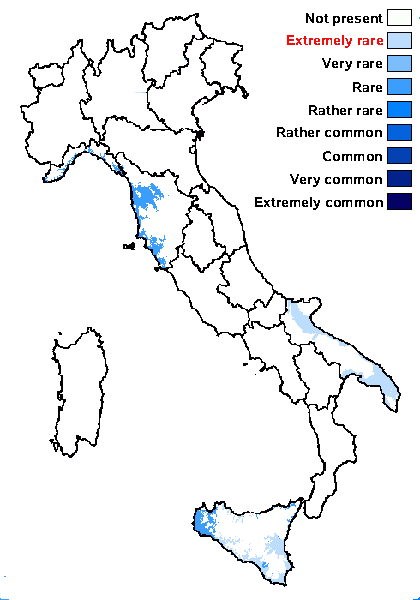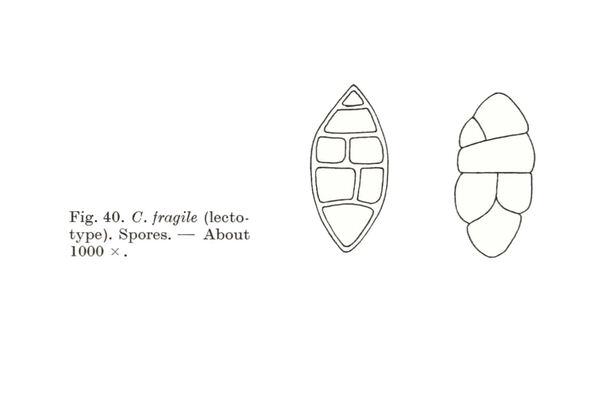Scytinium fragile (Taylor) Otálora, P.M. Jørg. & Wedin
Fungal Divers., 64, 1: 290, 2013. Basionym: Collema fragile Taylor in Mackay - Fl. Hibern., 2: 109 and 259, 1836.
Synonyms: Leptogium fragile (Taylor) Nyl.
Distribution: N - Piem (Morisi & Sereno 1995), Lig. C - Tosc (Ravera & al. 2023b). S - Pugl, Si.
Description: Thallus small-foliose to subcrustose-placodioid, closely attached, subgelatinous when wet, dark green-brown to black, of radiating, convex, 0.4-0.8(-1) mm wide, up to 400 μm thick (when wet), furcate lobes which are minutely white-pubescent at the tips, forming small, often confluent, up to 2-3(-5) cm wide rosettes. Upper surface with few to numerous, globose, 0.1-0.2 mm wide isidioid outgrowths. Pseudocortex of a single layer of isodiametrical, angular cells, sometimes absent or only partially developed. Apothecia very rare, lecanorine, 0.5-0.8 mm across, with a brown-black disc and a rather thick, finally sometimes excluded thalline margin. Proper exciple very thin, subparaplectenchymatous; epithecium brownish; hymenium and hypothecium colourless; paraphyses coherent, mostly simple, the apical cells slightly swollen. Asci 8-spored, cylindrical-clavate, the apex strongly thickened, the apical dome K/I+ pale blue, with a downwardly projecting K/I+ deep blue tubular structure. Ascospores submuriform, with 4 transverse septa and 1-2 longitudinal septa, hyaline, ellipsoid or ovoid, (20-)26-30 x 13-17 μm. Pycnidia rather rare. Conidia 4-5 x 1.5-2 μm. Photobiont cyanobacterial (Nostoc, the cells in rather short chains). Spot test: all negative. Chemistry: without lichen substances. Note: a southwestern species in Europe, found on steeply inclined seepage tracks of calcareous rocks; much overlooked and perhaps more widespread in Tyrrhenian Italy, but never common.
Growth form: Foliose, narrow lobed
Substrata: rocks
Photobiont: cyanobacteria, filamentous (e.g. Nostoc, Scytonema)
Reproductive strategy: mainly sexual
Most common in areas with a humid-warm climate (e.g. most of Tyrrenian Italy)
On otherwise dry surfaces with short periods of water seepage after rain
Commonnes-rarity: (info)
Alpine belt: absent
Subalpine belt: absent
Oromediterranean belt: absent
Montane belt: absent
Submediterranean belt: absent
Padanian area: absent
Humid submediterranean belt: absent
Humid mediterranean belt: rare
Dry mediterranean belt: extremely rare

Predictive model
Growth form: Foliose, narrow lobed
Substrata: rocks
Photobiont: cyanobacteria, filamentous (e.g. Nostoc, Scytonema)
Reproductive strategy: mainly sexual
Most common in areas with a humid-warm climate (e.g. most of Tyrrenian Italy)
On otherwise dry surfaces with short periods of water seepage after rain
Commonnes-rarity: (info)
Alpine belt: absent
Subalpine belt: absent
Oromediterranean belt: absent
Montane belt: absent
Submediterranean belt: absent
Padanian area: absent
Humid submediterranean belt: absent
Humid mediterranean belt: rare
Dry mediterranean belt: extremely rare

Predictive model
 Index Fungorum
Index Fungorum
 GBIF
GBIF



